Abstract
The NAD+-dependent isocitrate dehydrogenase from etiolated pea (Pisum sativum L.) mitochondria was purified more than 200-fold by dye-ligand binding on Matrix Gel Blue A and gel filtration on Superose 6. The enzyme was stabilized during purification by the inclusion of 20% glycerol. In crude matrix extracts, the enzyme activity eluted from Superose 6 with apparent molecular masses of 1400 ± 200, 690 ± 90, and 300 ± 50 kD. During subsequent purification steps the larger molecular mass species disappeared and an additional peak at 94 ± 16 kD was evident. The monomer for the enzyme was tentatively identified at 47 kD by sodium dodecyl-polyacrylamide gel electrophoresis. The NADP+-specific isocitrate dehydrogenase activity from mitochondria eluted from Superose 6 at 80 ± 10 kD. About half of the NAD+ and NADP+-specific enzymes remained bound to the mitochondrial membranes and was not removed by washing. The NAD+-dependent isocitrate dehydrogenase showed sigmodial kinetics in response to isocitrate (S0.5 = 0.3 mm). When the enzyme was aged at 4°C or frozen, the isocitrate response showed less allosterism, but this was partially reversed by the addition of citrate to the reaction medium. The NAD+ isocitrate dehydrogenase showed standard Michaelis-Menten kinetics toward NAD+ (Km = 0.2 mm). NADH was a competitive inhibitor (Ki = 0.2 mm) and, unexpectedly, NADPH was a noncompetitive inhibitor (Ki = 0.3 mm). The regulation by NADPH may provide a mechanism for coordination of pyridine nucleotide pools in the mitochondria.
Full text
PDF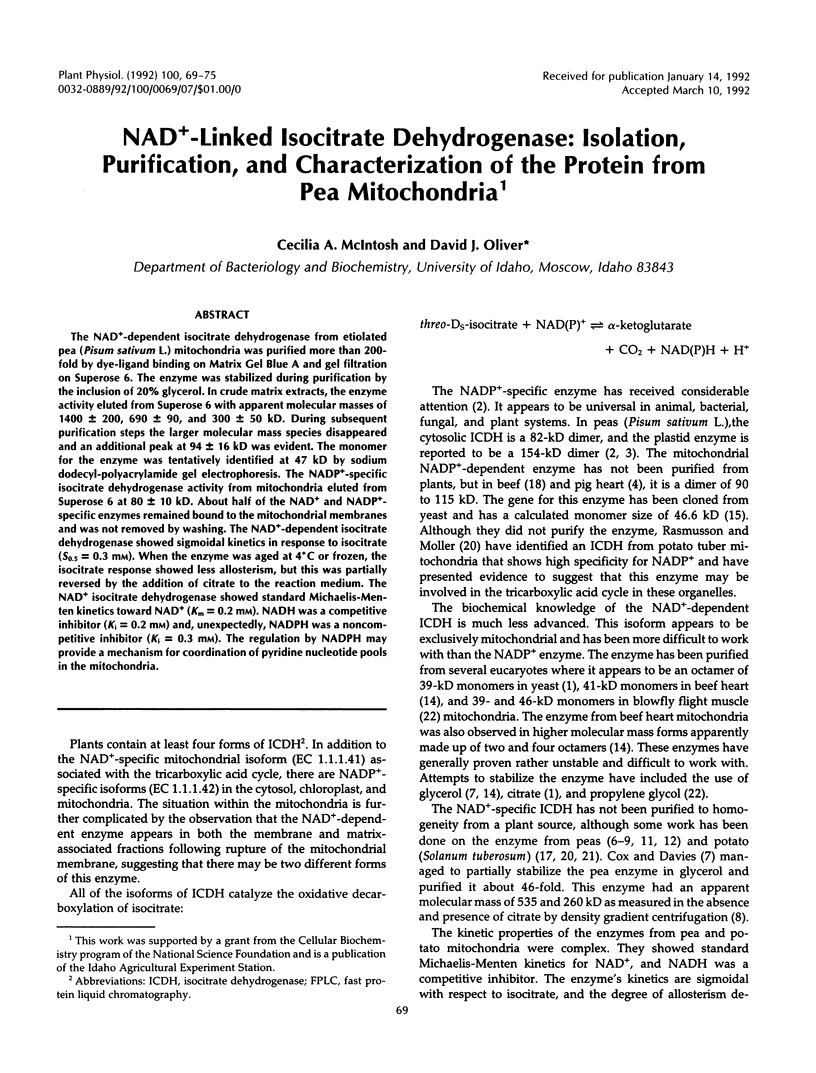
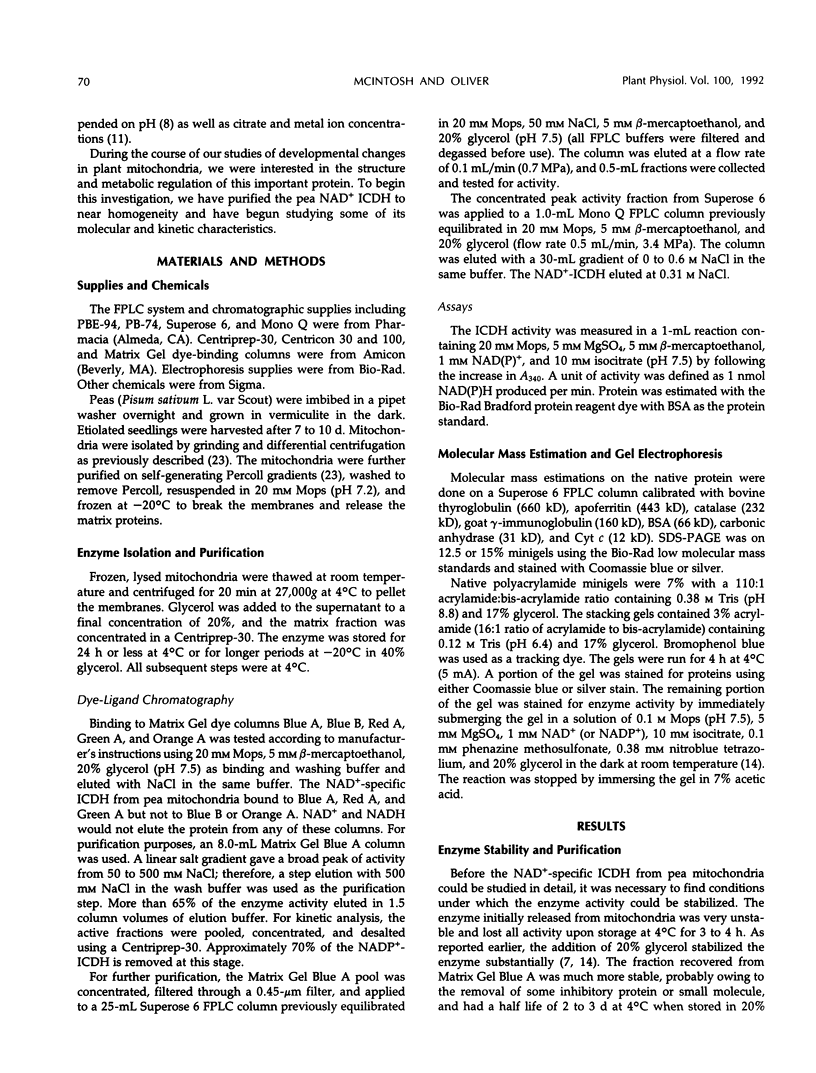
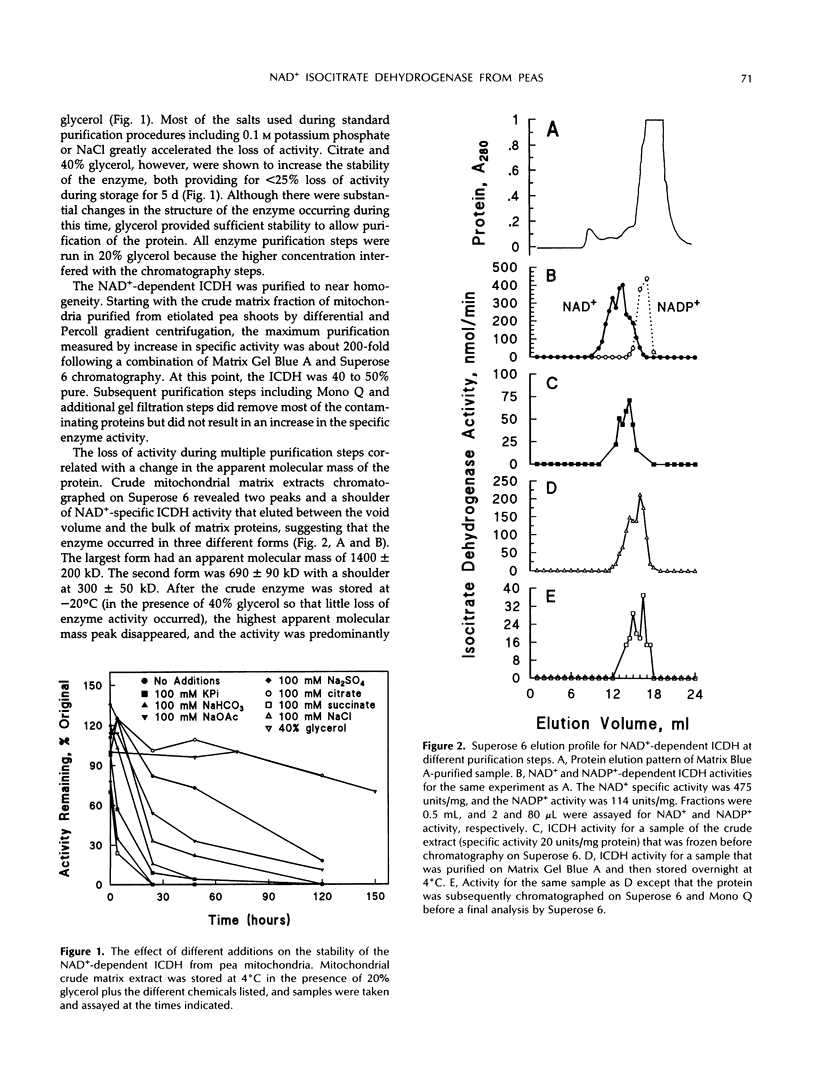
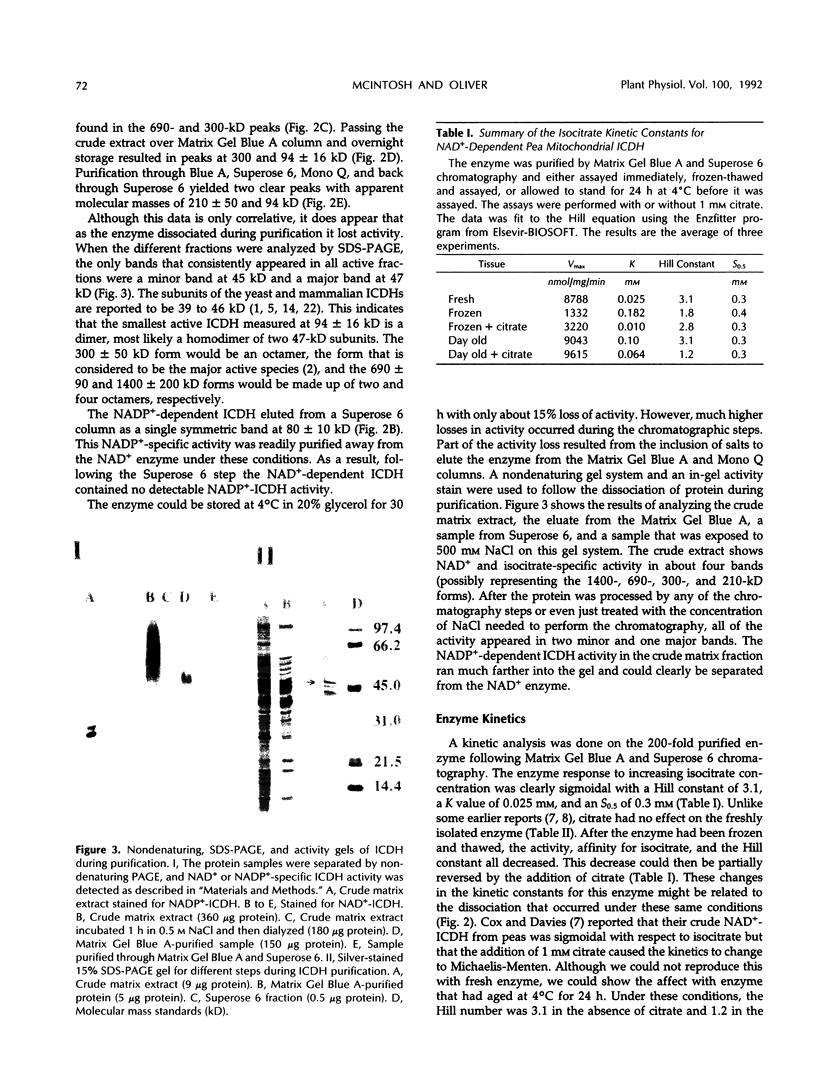
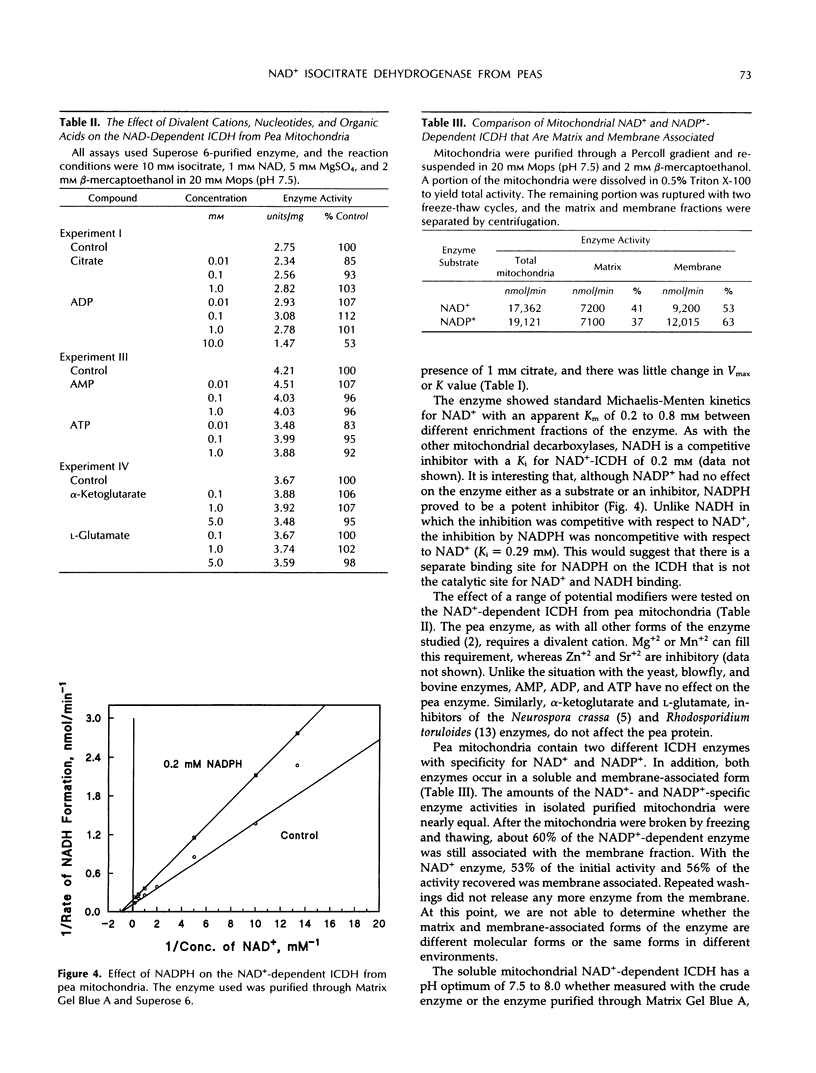
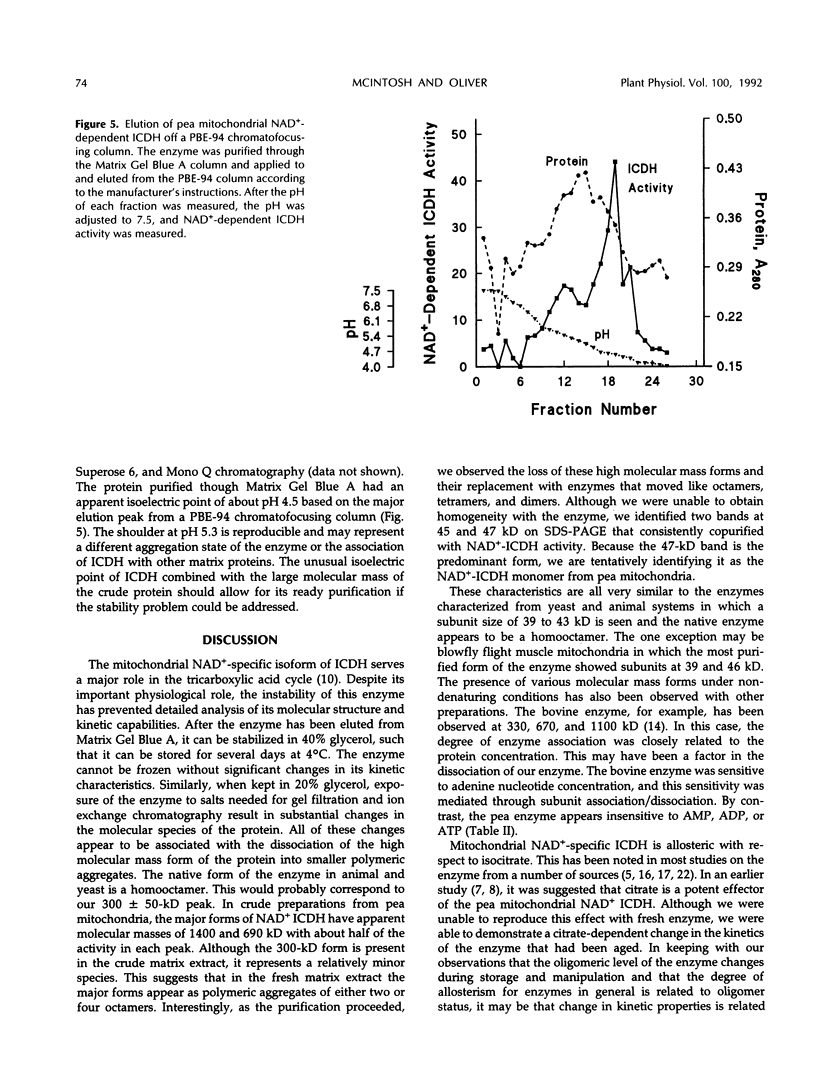
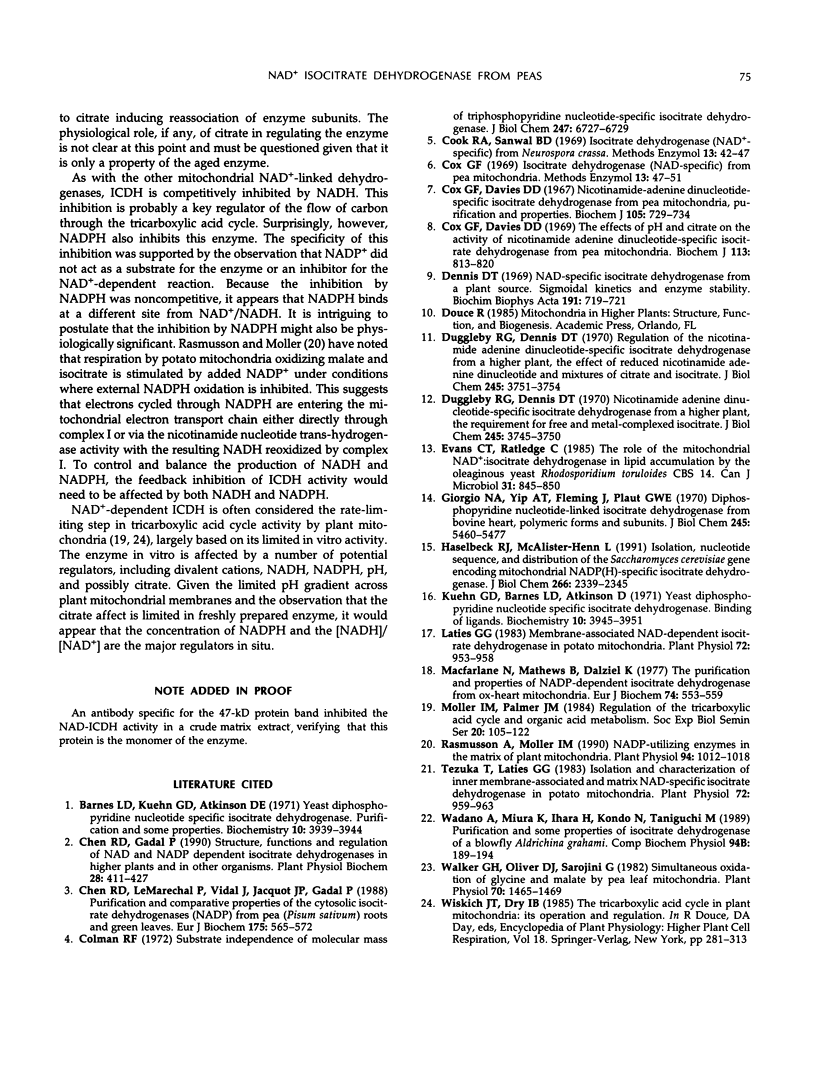
Images in this article
Selected References
These references are in PubMed. This may not be the complete list of references from this article.
- Barnes L. D., Kuehn G. D., Atkinson D. E. Yeast diphosphopyridine nucleotide specific isocitrate dehydrogenase. Purification and some properties. Biochemistry. 1971 Oct 12;10(21):3939–3944. doi: 10.1021/bi00797a022. [DOI] [PubMed] [Google Scholar]
- Chen R., Le Maréchal P., Vidal J., Jacquot J. P., Gadal P. Purification and comparative properties of the cytosolic isocitrate dehydrogenases (NADP) from pea (Pisum sativum) roots and green leaves. Eur J Biochem. 1988 Aug 15;175(3):565–572. doi: 10.1111/j.1432-1033.1988.tb14229.x. [DOI] [PubMed] [Google Scholar]
- Colman R. F. Substrate independence of molecular weight of triphosphopyridine nucleotide-specific isocitrate dehydrogenase. J Biol Chem. 1972 Oct 25;247(20):6727–6729. [PubMed] [Google Scholar]
- Cox G. F., Davies D. D. Nicotinamide-adenine dinucleotide-specific isocitrate dehydrogenase from pea mitochondria. Purification and properties. Biochem J. 1967 Nov;105(2):729–734. doi: 10.1042/bj1050729. [DOI] [PMC free article] [PubMed] [Google Scholar]
- Cox G. F., Davies D. D. The effects of pH and citrate on the activity of nicotinamideA-denine dinucleotide-specific isocitrate dehydrogenase from pea mitochondria. Biochem J. 1969 Aug;113(5):813–820. doi: 10.1042/bj1130813. [DOI] [PMC free article] [PubMed] [Google Scholar]
- Dennis D. T. NAD-specific isocitrate dehydrogenase from a plant source. Sigmoid kinetics and enzyme stability. Biochim Biophys Acta. 1969;191(3):719–721. doi: 10.1016/0005-2744(69)90367-2. [DOI] [PubMed] [Google Scholar]
- Duggleby R. G., Dennis D. T. Nicotinamide adenine dinucleotide-specific isocitrate dehydrogenase from a higher plant. The requirement for free and metal-complexed isocitrate. J Biol Chem. 1970 Aug 10;245(15):3745–3750. [PubMed] [Google Scholar]
- Duggleby R. G., Dennis D. T. Regulation of the nicotinamide adenine dinucleotide-specific isocitrate dehydrogenase from a higher plant. The effect of reduced nicotinamide adenine dinucleotide and mixtures of citrate and isocitrate. J Biol Chem. 1970 Aug 10;245(15):3751–3754. [PubMed] [Google Scholar]
- Giorgio N. A., Jr, Yip A. T., Fleming J., Plaut G. W. Diphosphopyridine nucleotide-linked isocitrate dehydrogenase from bovine heart. Polymeric forms and subunits. J Biol Chem. 1970 Oct 25;245(20):5469–5477. [PubMed] [Google Scholar]
- Haselbeck R. J., McAlister-Henn L. Isolation, nucleotide sequence, and disruption of the Saccharomyces cerevisiae gene encoding mitochondrial NADP(H)-specific isocitrate dehydrogenase. J Biol Chem. 1991 Feb 5;266(4):2339–2345. [PubMed] [Google Scholar]
- Kuehn G. D., Barnes L. D., Atkinson D. E. Yeast diphosphopyridine nucleotide specific isocitrate dehydrogenase. Binding of ligands. Biochemistry. 1971 Oct 12;10(21):3945–3951. doi: 10.1021/bi00797a023. [DOI] [PubMed] [Google Scholar]
- Laties G. G. Membrane-Associated NAD-Dependent Isocitrate Dehydrogenase in Potato Mitochondria. Plant Physiol. 1983 Aug;72(4):953–958. doi: 10.1104/pp.72.4.953. [DOI] [PMC free article] [PubMed] [Google Scholar]
- Macfarlane N., Mathews B., Dalziel K. The purification and properties of NADP-dependent isocitrate dehydrogenase from ox-heart mitochondria. Eur J Biochem. 1977 Apr 15;74(3):553–559. doi: 10.1111/j.1432-1033.1977.tb11424.x. [DOI] [PubMed] [Google Scholar]
- Rasmusson A. G., Møller I. M. NADP-Utilizing Enzymes in the Matrix of Plant Mitochondria. Plant Physiol. 1990 Nov;94(3):1012–1018. doi: 10.1104/pp.94.3.1012. [DOI] [PMC free article] [PubMed] [Google Scholar]
- Tezuka T., Laties G. G. Isolation and Characterization of Inner Membrane-Associated and Matrix NAD-Specific Isocitrate Dehydrogenase in Potato Mitochondria. Plant Physiol. 1983 Aug;72(4):959–963. doi: 10.1104/pp.72.4.959. [DOI] [PMC free article] [PubMed] [Google Scholar]
- Walker G. H., Oliver D. J., Sarojini G. Simultaneous oxidation of glycine and malate by pea leaf mitochondria. Plant Physiol. 1982 Nov;70(5):1465–1469. doi: 10.1104/pp.70.5.1465. [DOI] [PMC free article] [PubMed] [Google Scholar]



